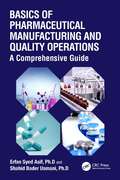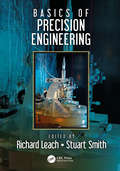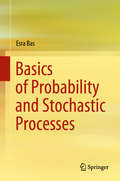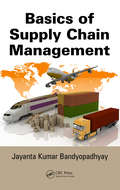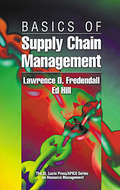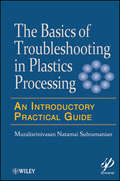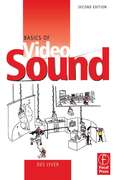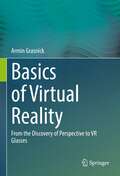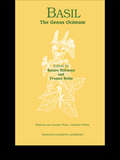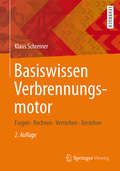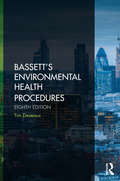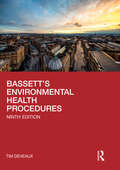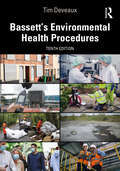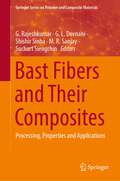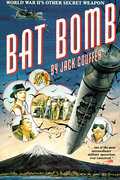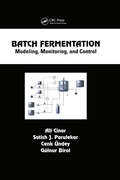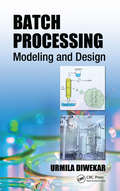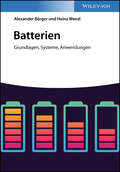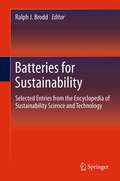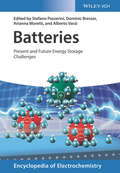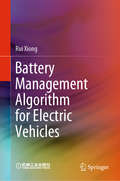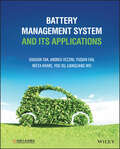- Table View
- List View
Basics of Pharmaceutical Manufacturing and Quality Operations: A Comprehensive Guide
by Erfan Syed Asif Shahid Bader UsmaniThis book provides guidance on how to meet the requirements of the pharmaceutical industry as a beginner. It includes procedures for production and packaging, batch auditing as well as all quality measures used in the pharmaceutical industry. This book also provides questions and answers with each chapter for institutes and trainers providing basic training to the new graduates and new comers to the industry.Basics of Pharmaceutical Manufacturing and Quality Operations: A Comprehensive Guide is primarily written for anyone in the pharmaceutical industry interested in development and manufacturing of active pharmaceutical ingredient (API) and finished pharmaceutical manufacturers in both sterile and non‑sterile areas. The book is a simple, concise, and easy to use reference tool covering basic quality concepts required by the pharmaceutical educational institutions and professional certification bodies. It describes details of all GXP activities that are directly related to Quality, Safety, and Efficacy of the products manufactured under the umbrella of Quality Operations, common testing methods which are used in any modern industry, Requirements of Validation and Qualification of equipment, facilities and processes, integral segments of Drug product manufacturing, storage, and distribution practices. The material provides stepwise guidance on how to evaluate, audit, qualify, and approve a pharmaceutical product to enhance the GMP within the industry.The book is written with the idea of providing basic knowledge to undergraduate students who are preparing to enter the industry at the end of their graduation. The book would also be beneficial for institutions conducting pharmaceutical technology study courses in terms of GMP and GLP applications.Features: Provides readers and front line health care product manufacturers, all the information they need to know to develop a GMP oriented industry with trained and skilled personnel and manufacture products that meet GMP and regulatory requirements. Provides stepwise guidance on how to evaluate, audit, qualify, and approve a pharmaceutical product and packaging material to enhance the GMP within the industry. Includes significant processes and steps in production for all common dosage forms. Explains how in‑process and finished products are released. Provides an ideal and effective tool for anyone starting Quality Assurance/Quality control/Production responsibilities.
Basics of Precision Engineering
by Richard Leach Stuart T. SmithAdvances in engineering precision have tracked with technological progress for hundreds of years. Over the last few decades, precision engineering has been the specific focus of research on an international scale. The outcome of this effort has been the establishment of a broad range of engineering principles and techniques that form the foundation of precision design. Today’s precision manufacturing machines and measuring instruments represent highly specialised processes that combine deterministic engineering with metrology. Spanning a broad range of technology applications, precision engineering principles frequently bring together scientific ideas drawn from mechanics, materials, optics, electronics, control, thermo-mechanics, dynamics, and software engineering. This book provides a collection of these principles in a single source. Each topic is presented at a level suitable for both undergraduate students and precision engineers in the field. Also included is a wealth of references and example problems to consolidate ideas, and help guide the interested reader to more advanced literature on specific implementations.
Basics of Probability and Stochastic Processes
by Esra BasThis textbook explores probability and stochastic processes at a level that does not require any prior knowledge except basic calculus. It presents the fundamental concepts in a step-by-step manner, and offers remarks and warnings for deeper insights. The chapters include basic examples, which are revisited as the new concepts are introduced. To aid learning, figures and diagrams are used to help readers grasp the concepts, and the solutions to the exercises and problems. Further, a table format is also used where relevant for better comparison of the ideas and formulae. The first part of the book introduces readers to the essentials of probability, including combinatorial analysis, conditional probability, and discrete and continuous random variable. The second part then covers fundamental stochastic processes, including point, counting, renewal and regenerative processes, the Poisson process, Markov chains, queuing models and reliability theory. Primarily intended for undergraduate engineering students, it is also useful for graduate-level students wanting to refresh their knowledge of the basics of probability and stochastic processes.
Basics of Supply Chain Management
by Jayanta Kumar BandyopadhyayThe practice of supply chain management has become widespread in most industries. It is now included in the curriculum of many business schools in the United States and in many countries around the world. A number of professional associations, such as the American Production and Inventory Control Society and the Supply Chain Management Society, off
Basics of Supply Chain Management (Resource Management)
by Lawrence D. Fredendall Ed HillSupply Chain Management (SCM) was once a "pie in the sky" concept that could not be fully achieved. A key barrier was the cost of communicating with and coordinating among the many independent suppliers in each supply chain. SCM is possible because of three changes: technology has developed that simplifies communication, new management paradigms ha
Basics of Troubleshooting in Plastics Processing: An Introductory Practical Guide (Wiley-Scrivener #51)
by Muralisrinivasan Natamai SubramanianThe Basics of Troubleshooting in Plastics Processing is a condensed practical guide that gives the reader a broad introduction to properties of thermoplastics plastics, additives, the major processes (extrusion, injection molding, rotational molding, blow molding, and thermoforming), as well as troubleshooting. The main goal is to provide the plastics processor with an improved understanding of the basics by explaining the science behind the technology. Machine details are minimized as the emphasis is on processing problems and the defects in an effort to focus on basic root causes to problems and how to solve them. The book’s framework is troubleshooting in plastics processing because of the importance it has to the eventual production of high quality end products. Each chapter contains both practical and detailed technical information. This basic guide provides state-of-the-art information on: Processing problems and defects during manufacturing Plastics materials, their properties and characterization The plastics processing techniques Plastics additives Troubleshooting of the 5 main plastics processes References for further reading
Basics of Video Sound
by Des LyverNow fully updated to reflect the latest advances, the second edition of Basics of Video Sound is a primer for anyone wishing to learn about recording sound. It describes the principles and processes involved in obtaining professional results in educational, training and corporate environments. Assuming little prior knowledge, this book covers everything from how to choose a microphone and obtain the best quality recordings, to editing the results for the final screening. It features:· the latest advances in the use of disc and minidisc systems, computer based editing in audio post production· coverage of studio and location work· descriptions of the role of each crew member · full explanations of technical terms· health and safety precautions· practical advice on the equipment available and how to use itBasics of Video Sound aims to provide the reader with a rapid understanding of what is actually a complex process, without getting too bogged down in technical terms. It is equipment non-specific and references to technical matters are only included where necessary to understanding, for example a short explanation of the electricity and physics that is needed in order to become a good sound recordist.
Basics of Virtual Reality: From the Discovery of Perspective to VR Glasses
by Armin GrasnickToday, the reality we know can be recorded and reproduced true to reality using technical processes. Space and time are recreated virtually as a copy in artificial reality. However, the reproduction of virtual reality is not limited to a mere copy of what exists. A visitor to the virtual space does not have to be content with the pixelated image of the old familiar, but can encounter unreal phenomena in the illusory world that never existed in real life or are even physically impossible. This enables an expansion of the recorded reality and allows the perception of surprisingly new perspectives.A perspective denotes the perception of a fact from a certain point of view and corresponds to the way of looking at things. But a perspective is also the observation of a scene from a viewing position. From different perspectives the illusion of reality arises during the reproduction by observation. This vision is not based on imagination or hallucination, but is the basic function of virtual reality. This book describes the concepts, systems, and technologies used to create virtual reality from its ancient beginnings to the present, and provides a glimpse into a possible future.This book is a translation of the original German 1st edition Grundlagen der virtuellen Realität by Armin Grasnick, published by Springer-Verlag GmbH Germany, part of Springer Nature in 2020. The translation was done with the help of artificial intelligence (machine translation by the service DeepL.com). A subsequent human revision was done primarily in terms of content, so that the book will read stylistically differently from a conventional translation. Springer Nature works continuously to further the development of tools for the production of books and on the related technologies to support the authors.
Basil: The Genus Ocimum (Medicinal And Aromatic Plants - Industrial Profiles Ser.)
by Raimo Hiltunen Yvonne HolmCovering all the research areas regarding Ocimum such as botany, chemistry and pharmacology, this book will be of interest to everybody involved in medicinal and aromatic plant research or related fields.
Basiswissen Verbrennungsmotor: Fragen - rechnen - verstehen - bestehen
by Klaus SchreinerDieses etwas andere Lehrbuch führt in die Berechnung von Verbrennungsmotoren ein, indem es von aktuellen Fragestellungen z. B. der Fahrzeugdynamik oder Motorthermodynamik ausgeht und bei der Lösung die notwendige Theorie herleitet. Damit man in das Buch auch quer einsteigen kann, ist in einem eigenen Verzeichnis aufgeführt, welche theoretischen Kenntnisse man für die Lösung der jeweiligen Aufgabe benötigt und in welchem Abschnitt des Buches diese hergeleitet wurden. Alle Berechnungen werden in Excel durchgeführt. In der aktuellen Auflage wurden 20 völlig neue Fragestellungen mit aufgenommen.
Basiswissen Verbrennungsmotor: Fragen – rechnen – verstehen – bestehen
by Klaus SchreinerDieses besondere Lehrbuch führt in die Berechnung von Verbrennungsmotoren ein, geht dabei von aktuellen Fragestellungen z. B. zur Fahrzeugdynamik und Motorthermodynamik aus und stellt bei der Lösung die notwendige Theorie mit bereit. Damit auch Quereinsteiger erfolgreich sind, ist in einem Verzeichnis aufgeführt, welche theoretischen Kenntnisse man für die Lösung der jeweiligen Aufgabe benötigt und in welchem Abschnitt des Buches diese hergeleitet werden. Alle Berechnungen werden in Excel durchgeführt. In der vorliegenden Auflage wurden aktuelle Beispiele zur Motoreffizienz, zum Motorkennfeld, zur Lastpunktanhebung, zum Fahrzyklus WLTC und zu realen Fahrzyklen (RDE) ergänzt.
Bassett's Environmental Health Procedures
by Tim Deveaux W.H. BassettEnvironmental health law is a wide-ranging, detailed and complex body of law within the UK. Environmental Health Procedures is an established and essential reference source which provides an accessible entry into enforcement and administrative procedures for environmental health. The main legal procedures used in the environmental health field are presented as flow charts supported by explanatory text. The structure of this eighth edition has been revised for ease of use, with each chapter now addressing a single topic instead of a piece of legislation. It also introduces legal guidance for environmental health practitioners to prepare them for the court prosecutions that are an essential part of their work. The book has been updated throughout to reflect new practices, legislation and statutory guidance including: Primary Authorities Authorisations for public water supplies Infectious disease control Port Health RIDDOR Environmental permitting Environmental damage Imported food Empty homes Licensing of housing Licensing of gambling activities Environmental Health Officers/Practitioners and students will find this book invaluable. It will also be an essential reference for all those whose responsibilities demand they keep abreast of current environmental health practices.
Bassett's Environmental Health Procedures
by Tim Deveaux W.H. BassettEnvironmental health law is a wide-ranging, detailed and complex body of law within the UK. Bassett’s Environmental Health Procedures is an established and essential reference source which provides an accessible entry into enforcement and administrative procedures for environmental health. The main legal procedures used in the environmental health field are presented as flow charts supported by explanatory text. This ninth edition refines the structure introduced in the eighth edition, with each chapter addressing a single topic. It has introduced the titles of the corresponding legislation in Scotland and Northern Ireland where there is such legislation. The book has been updated throughout to reflect new practices, legislation and statutory guidance. Specifically, the ninth edition contains new content on Antisocial Behaviour and significant updates to sections on: Enforcement and Administration Environmental Protection Food Safety Housing and Public Health Environmental Health Officers/Practitioners and students will find this book invaluable. It will also be an essential reference for all those whose responsibilities demand they keep abreast of current environmental health practices.
Bassett's Environmental Health Procedures
by Tim Deveaux W.H. BassettBassett’s Environmental Health Procedures is a long-standing, must-have reference book for practising environmental health officers in local government and in private practice. It covers all the key legislative procedures for the service of a wide range of notices to deal with public health problems throughout the UK. The tenth edition covers the following subjects and reflects new practices, legislation and statutory guidance: The legal framework Environmental protection – including air quality, noise, pollution control Food safety Health and safety at work Housing Port health Public health Each procedure includes a simple description of the legislation and a flow diagram showing the procedure to follow in using that legislation. Written for the increasingly pressurised local authority environmental health practitioner, this book will help them to understand the legislation quickly and easily and how to deploy it effectively. Bassett’s is also an essential reference for all those whose responsibilities demand they keep abreast of current environmental health practices.
Bast Fibers and Their Composites: Processing, Properties and Applications (Springer Series on Polymer and Composite Materials)
by Suchart Siengchin G. Rajeshkumar Shishir Sinha G. L. Devnani M. R. SanjayThis edited book focuses on processing, properties, and applications of bast fiber and its composites written by renowned researchers and academicians. The contents focus on properties such as rheological and dielectric of bast fiber composites. It also discusses its dynamic mechanical analysis, thermal stability of polymer composites reinforced with bast fibers, and water absorption behavior of bast fiber incorporated polymer composites. This book will be beneficial to both the industry and academia as it highlights possible avenues of future research.
Bat Bomb: World War II's Other Secret Weapon
by Jack Couffer&“Inside information on a wondrously droll, highly classified yarn from WWII . . . A well-told, stranger-than-fiction tale that could make a terrific movie.&” —Kirkus Reviews The plan: attach small incendiary bombs to millions of bats and release them over Japan&’s major cities. As the bats went to roost, a million fires would flare up in remote crannies of the wood and paper buildings common throughout Japan. When their cities were reduced to ashes, the Japanese would surely capitulate . . . Told here by the youngest member of the team, this is the story of the bat bomb project, or Project X-Ray, as it was officially known. In scenes worthy of a Capra or Hawks comedy, Jack Couffer recounts the unorthodox experiments carried out in the secrecy of Bandera, Texas, Carlsbad, New Mexico, and El Centro, California, in 1942-1943 by &“Doc&” Adams&’ private army. This oddball cast of characters included an eccentric inventor, a distinguished Harvard scientist, a biologist with a chip on his shoulder, a movie star, a Texas guano collector, a crusty Marine Corps colonel, a Maine lobster fisherman, an ex-mobster, and a tiger. The bat bomb researchers risked life and limb to explore uncharted bat caves and &“recruit&” thousands of bats to serve their country, certain that they could end the war with Japan. And they might have—in their first airborne test, the bat bombers burned an entire brand-new military airfield to the ground. For everyone who relishes true tales of action and adventure, Bat Bomb is a must-read. Bat enthusiasts will also discover the beginnings of the scientific study of bats.
Batch Adsorption Process of Metals and Anions for Remediation of Contaminated Water
by Faizal Bux Deepak GusainAdsorption is one of the method that is in use for remediation of contaminated water. The experimental factors affecting the batch mode of adsorption of various metals and inorganic anions are discussed in this book. The elemental contaminants have been categorized into four major categories i.e. major toxic elements; essential elements having toxicity on excessive exposure; miscellaneous elements having undetermined effects; non-toxic elements having trivial or unidentified significance. In addition, anions like nitrate, perchlorate and sulphate as water contaminants are considered. This unique volume fills a niche in the area of water treatment. Key Features: Provides practitioners with the background they need to understand and apply batch adsorption processes to the purification of water Describes the actions of adsorption capacity or percentage removal with respect to factors affecting the adsorption process Excellent source of information for those working in the industry for remediation of metals and anions Discusses the current era of Anthropocene which is highly dependent on the anthropogenic mineral sources for its sustenance
Batch Fermentation: Modeling: Monitoring, and Control (Chemical Industries)
by Ali Cinar Satish J. Parulekar Cenk Undey Gulnur BirolIllustrating techniques in model development, signal processing, data reconciliation, process monitoring, quality assurance, intelligent real-time process supervision, and fault detection and diagnosis, Batch Fermentation offers valuable simulation and control strategies for batch fermentation applications in the food, pharmaceutical, and chemical industries. The book provides approaches for determining optimal reference trajectories and operating conditions; estimating final product quality; modifying, adjusting, and enhancing batch process operations; and designing integrated real-time intelligent knowledge-based systems for process monitoring and fault diagnosis.
Batch Processing: Modeling and Design
by Urmila DiwekarBatch processes are widely used in pharmaceutical, food, and specialty chemicals where high value, low volume products are manufactured. Designing these processes and unit operations can be an onerous task that requires computational efforts. With examples, case studies, and more than 100 homework problems, this book presents an overview of computer-aided design packages and describes the unit operations in batch and bioprocessing. Providing students with a thorough grounding in the numerical methods necessary to solve design problems, it discusses the basics of design, modeling, and optimization. Figure slides are available upon qualifying course adoption.
Batterien: Grundlagen, Systeme, Anwendungen
by Heinz Wenzl Alexander BörgerBatterien Für die Mobilität und Energieversorgung der Zukunft: Kompakte und praxisnahe Wissensvermittlung aller wichtigen Batteriegrundlagen und -systeme Batterien sind in vielen Fällen die bevorzugte Lösung zur technischen und wirtschaftlichen Optimierung von Fahrzeugen und Energieversorgungsystemen und ermöglichen es, Emissionen zu verringern und die Abhängigkeit von Erdöl und Erdgas zu reduzieren. In der Summe aller Eigenschaften erfüllen Blei-Säure-Batterien und Lithium-Ionen-Batterien die Anforderungen der verschiedensten Anwendungen am besten und dominieren deshalb den Markt. Lithium-Ionen-Batterien dringen in immer weitere Anwendungsgebiete vor, bzgl. Wert und Produktionsmenge in MWh dominieren aber immer noch Blei-Säure-Batterien. Aus Sicht der Autoren sind Kenntnisse beider Batterietechnologien wichtig, um das Verständnis für Batteriesysteme zu vertiefen und sie in den seltenen Fällen, in denen diese beiden Batterietechnologien technische oder wirtschaftliche Alternativen sind, gegeneinander abzuwägen. Die Anforderungen an Batteriesysteme sind hoch. Sie müssen leicht und häufig ladbar sein und müssen thermisch, elektrisch und mechanisch stabil sein. In der Batterieforschung kommt materialwissenschaftliches, elektrochemisches und Ingenieurwissen zusammen. Die Autoren Alexander Börger und Heinz Wenzl geben mit diesem Buch einen umfassenden und kompakten Überblick zu den Grundlagen, Systemen und Anwendungen der Batterietechnik. Es werden Hintergründe zum Aufbau von Batterien und grundlegende Prozesse anschaulich erläutert. Anhand vieler Beispiele wird gezeigt, wie das Wissen in die Praxis umgesetzt wird. Klarer Fokus: Das Buch legt den Schwerpunkt auf Batteriesysteme, ihre Eigenschaften im Betrieb und Anwendungen. Das Buch ist als Begleitlektüre zum Studium verwendbar. Wachstumsmarkt: Das Interesse an Elektromobilität und Batteriespeichern in der Stromversorgung wächst und damit auch der Bedarf an Batteriesystemen. Anwendungsnah: Fallbeispiele aus der aktuellen Batterieentwicklung setzen die Theorie in die Praxis um. Expertenwissen: Die Autoren verfügen über langjährige Erfahrung auf dem Gebiet der Batterietechnik. Batterien: Grundlagen, Systeme, Anwendungen richtet sich an Ingenieurinnen und Ingenieure zur Einarbeitung in die Materie und als Nachschlagewerk sowie an Studierende als Begleitlektüre zu Vorlesungen.
Batteries for Electric Vehicles
by Helena BergThis fundamental guide will teach you the basics of battery design for electric vehicles. Working through this book, you will understand how to optimise battery performance and functionality, whilst minimising costs and maximising durability. Beginning with the basic concepts of electrochemistry, the author moves on to describe implementation, control and management of batteries in real vehicles, with respect to the battery materials. The author describes how to select cells and batteries with explanations of the advantages and disadvantages of different battery chemistries, enabling you to put your knowledge into practice and make informed and successful design decisions, with a thorough understanding of the trade-offs involved. The first of its kind, and written by an industry expert with experience in academia, this is an ideal resource for both students and researchers in the fields of battery research and development as well as for professionals in the automotive industry extending their interest towards electric vehicles.
Batteries for Sustainability: Selected Entries from the Encyclopedia of Sustainability Science and Technology
by Ralph J. BroddBatteries that can store electricity from solar and wind generation farms are a key component of a sustainable energy strategy. Featuring 15 peer-reviewed entries from the Encyclopedia of Sustainability Science and Technology, this book presents a wide range of battery types and components, from nanocarbons for supercapacitors to lead acid battery systems and technology. Worldwide experts provides a snapshot-in-time of the state-of-the art in battery-related R&D, with a particular focus on rechargeable batteries. Such batteries can store electrical energy generated by renewable energy sources such as solar, wind, and hydropower installations with high efficiency and release it on demand. They are efficient, non-polluting, self-contained devices, and their components can be recovered and used to recreate battery systems. Coverage also highlights the significant efforts currently underway to adapt battery technology to power cars, trucks and buses in order to eliminate pollution from petroleum combustion. Written for an audience of undergraduate and graduate students, researchers, and industry experts, Batteries for Sustainability is an invaluable one-stop reference to this essential area of energy technology.
Batteries: Present and Future Energy Storage Challenges (Encyclopedia of Electrochemistry)
by Stefano PasseriniPart of the Encyclopedia of Electrochemistry, this comprehensive, two-volume handbook offers an up-to-date and in-depth review of the battery technologies in use today. It also includes information on the most likely candidates that hold the potential for further enhanced energy and power densities. It contains contributions from a renowned panel of international experts in the field. Batteries are extremely commonplace in modern day life. They provide electrochemically stored energy in the form of electricity to automobiles, aircrafts, electronic devices and to smart power grids. Comprehensive in scope, 'Batteries' covers information on well-established battery technologies such as charge-carrier-based lead acid and lithium ion batteries. The contributors also explore current developments on new technologies such as lithium-sulfur and -oxygen, sodium ion, and full organic batteries. Written for electrochemists, physical chemists, and materials scientists, 'Batteries' is an accessible compendium that offers a thorough review of the most relevant current battery technologies and explores the technology in the years to come.
Battery Management Algorithm for Electric Vehicles
by Rui XiongThis book systematically introduces readers to the core algorithms of battery management system (BMS) for electric vehicles. These algorithms cover most of the technical bottlenecks encountered in BMS applications, including battery system modeling, state of charge (SOC) and state of health (SOH) estimation, state of power (SOP) estimation, remaining useful life (RUL) prediction, heating at low temperature, and optimization of charging. The book not only presents these algorithms, but also discusses their background, as well as related experimental and hardware developments. The concise figures and program codes provided make the calculation process easy to follow and apply, while the results obtained are presented in a comparative way, allowing readers to intuitively grasp the characteristics of different algorithms. Given its scope, the book is intended for researchers, senior undergraduate and graduate students, as well as engineers in the fields of electric vehicles and energy storage.
Battery Management System and its Applications
by Xiaojun Tan Andrea Vezzini Yuqian Fan Neeta Khare You Xu Liangliang WeiBATTERY MANAGEMENT SYSTEM AND ITS APPLICATIONS Enables readers to understand basic concepts, design, and implementation of battery management systems Battery Management System and its Applications is an all-in-one guide to basic concepts, design, and applications of battery management systems (BMS), featuring industrially relevant case studies with detailed analysis, and providing clear, concise descriptions of performance testing, battery modeling, functions, and topologies of BMS. In Battery Management System and its Applications, readers can expect to find information on: Core and basic concepts of BMS, to help readers establish a foundation of relevant knowledge before more advanced concepts are introduced Performance testing and battery modeling, to help readers fully understand Lithium-ion batteries Basic functions and topologies of BMS, with the aim of guiding readers to design simple BMS themselves Some advanced functions of BMS, drawing from the research achievements of the authors, who have significant experience in cross-industry research Featuring detailed case studies and industrial applications, Battery Management System and its Applications is a must-have resource for researchers and professionals working in energy technologies and power electronics, along with advanced undergraduate/postgraduate students majoring in vehicle engineering, power electronics, and automatic control.
